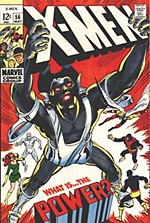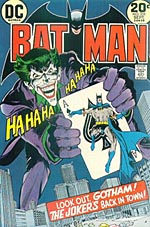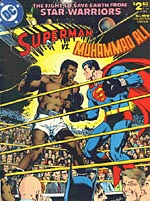
EARLY DAYS
Neal Adams was born on Governors Island, NY on June 6th 1941. As a child he was interested in both art and science, but he couldn't afford to attend college - his father left home when Neal was 13 - so he enrolled at a vocational high school for aspiring artists, the School of Industrial Arts (now the School of Art & Design) in Manhattan. He attempted to get work with DC after leaving school, but was told that the industry was closed to new artists.
LANDMARKS
1959 - 1967 - Adams was published by Archie Comics. He drew backgrounds for various newspaper comic strips and, for 31/2 years, wrote and drew the BEN CASEY strip.
April 1967 - CREEPY issues #14-16 include Adams' first works for Warren Publishing. Adams' art is already highly polished at this time. He returned to Warren in April 1970 with the story "Rock God" in CREEPY #32, his first joint effort with renowned science fiction writer Harlan Ellison. They would continue to collaborate sporadically over the next 25 years.
Nov 1967 - STRANGE ADVENTURES #206 sees Adams on one of DC's oddest characters - Deadman. This early work shows the strong graphic design sense that Adams brought to mainstream comics. Innovative layouts and realistic musculature made this a very different book to what was the norm at the time. At just 26, Adams created the first in a body of works to leave a lasting impact on the comics industry. Adams was showing that distinctive new artists in the comics field could influence him too, as the background to one panel in issue #216 swirled to form the words "Hey! A Jim Steranko effect". Steranko, then working on Marvel's NICK FURY AGENT OF SHIELD, shared with Adams a background in commercial illustration.
Aug 1968 - THE BRAVE AND THE BOLD #79, a turning point for both the Batman titles and for Adams. THE BRAVE AND THE BOLD was a lower tier Bat book, and since issue #67 had been dedicated to team-ups between Batman and various DC guest stars, but Adams' nine issue stint on the title was the high water mark for the 200 issue run. Bizarre guest appearances by Deadman (completing the story from STRANGE ADVENTURES), Sgt Rock, the Creeper, Green Arrow and, weirdest of all, The House of Mystery, made this a highly entertaining, run.
Adams' subtle redesign of the Batman costume - slightly longer "ears" on the cowl, an increased emphasis on the size of the cape - was an attempt to get away from the stereotyped TV Batman. Adams also introduced other new elements to Batman's visual style; "When the scripts came in with Batman entering a room, I wouldn't have him walk through the door. I'd have him come through the window or step out of the shadows. I found ways of altering him without offending the writer - making him more mysterious, dark, dangerous". Adams created the template that would lead, 17 years later, to self-confessed Adams fan Frank Miller's groundbreaking THE DARK KNIGHT RETURNS.
 May 1969 - Adams was widely recognised as the most innovative artist in comics, and a conversation with Jim Steranko lead to new opportunities - "I was inspired to come to Marvel to a great degree by Jim Steranko. He dropped into DC's offices [and] described the Marvel style to me: Basically they just let you free to do whatever you wanted to do, and you just went ahead and did it". Stan Lee supposedly offered Adams the choice of any Marvel title he wanted, so Adams asked for Marvel's worst selling title. At the time it was a six-year-old team book that had chopped and changed creative teams rapidly over the last year and was headed towards cancellation - X-MEN.
May 1969 - Adams was widely recognised as the most innovative artist in comics, and a conversation with Jim Steranko lead to new opportunities - "I was inspired to come to Marvel to a great degree by Jim Steranko. He dropped into DC's offices [and] described the Marvel style to me: Basically they just let you free to do whatever you wanted to do, and you just went ahead and did it". Stan Lee supposedly offered Adams the choice of any Marvel title he wanted, so Adams asked for Marvel's worst selling title. At the time it was a six-year-old team book that had chopped and changed creative teams rapidly over the last year and was headed towards cancellation - X-MEN.
For his first issue, #56, Adams united with writer/dialoguer Roy Thomas. Along with inker Tom Palmer they turned a previously moribund title into an industry-wide talking point. This team worked together on eight of the next ten issues of X-MEN (#64 was drawn by Don Heck in a recognisably Adams-influenced style, and #65 was dialogued by Denny O'Neil), but the buzz on the title wasn't reflected in the sales. The book was cancelled with #66.
Adams' run on X-MEN introduced and re-introduced a number of characters that have proved to have enduring appeal with later X-artists - Magneto, the Sentinels, Havok, Sauron, Ka-Zar. Adams later said; "One of the things I and others observed was that after the X-MEN was cancelled, almost every new artist and writer that came to Marvel wanted to do the X-MEN because of those ten issues. And as the book was passed to each in his turn, they all do Sauron, they all do the Sentinels ... they all do Magneto."
1970 - Adams returns to DC, to work on a major Batman book - DETECTIVE COMICS - and produces eight issues between #395 and #410. The majority of these are written by Denny O'Neil and inked by Dick Giordano, and the standout issues are #400, the introduction of Man-Bat, and #404, where Batman meets Enemy Ace in a tribute to Joe Kubert. However, it is the second title that Adams works on this year that is remembered as his creative peak.
Apr 1970 - GREEN LANTERN/GREEN ARROW #76. GREEN LANTERN was yet another ailing title, and it can be argued that Adams was allowed more leeway in his striking design and layouts here because he was working on a book that was already close to cancellation. In his work on higher selling books, especially DETECTIVE COMICS and BATMAN, his layouts were much more conservative and generally confined to a six-panel grid.
GL/GA #76 saw the introduction of Green Arrow as co-headliner. Green Arrow's portrayal was based on that first seen in the Adams-drawn THE BRAVE AND THE BOLD #85. The creative team was much the same as that on DETECTIVE COMICS - Denny O'Neil writing and Dick Giordano inking - and the stories focused on social issues of the time, including racism, pollution, religious sects and, most famously, drug abuse. The highly controversial #85 and 86 dealt with the heroin addiction of Green Arrow's former sidekick Roy Harper (unfortunately codenamed Speedy). The story helped lead to a relaxation of Comics Code Authority regulations on what could be shown in comics.
Sadly, the title was cancelled with # 89, although Adams and O'Neil reunited to continue their version of Green Lantern as a back up in the pages of THE FLASH.
 1971 - Adams took on two new titles, BATMAN for DC and THE AVENGERS for Marvel.
1971 - Adams took on two new titles, BATMAN for DC and THE AVENGERS for Marvel.
Adams seemed to have a greater affinity for BATMAN than for DETECTIVE COMICS, as shown in the quality of his art and imagination. He only drew nine issues of Batman, but the stories covered the introduction of Ra's Al Ghul, the return of Two-Face, and best of all, "The Joker's Five-Way Revenge". This defining first modern-day appearance of the murderous, psychotic version of The Joker still holds sway to this day, influencing excellent stories from Steve Englehart, Alan Moore, Frank Miller, Grant Morrison and more.
As for THE AVENGERS, Adams came onboard with # 93, the start of Roy Thomas' famous Kree/Skrull war. However, after his superb depictions of space warfare and alien creatures, a disagreement with Thomas and a fill-in on issue #97 by John Buscema saw Adams walk away from the book after drawing only three issues.
1972 - Long DC's most prominent cover artist, Adams now cuts back on his interior pencils dramatically. However, one standout piece from this period was DRACULA LIVES #2, scripted by Marv Wolfman, for which Adams employed a gorgeous - but time consuming - wash effect.
1974 - Adams joins the fight to get Jerry Siegel and Joe Shuster the royalty payments they claim DC owes them for their work on Superman since the character's creation, and it absorbs much of his time. The campaign eventually leads to DC paying Siegel and Shuster a $35,000 per year "pension", and crediting them for the character's creation. Adams also fights for artists to have their original art returned, opening up for them a lucrative side market. At that time, DC kept the art for three months and then destroyed it.
 1978 - The much-publicised SUPERMAN VS MUHAMMAD ALI TREASURY EDITION appears. The story is exactly as hokey as you'd expect, but the art is outstanding. The 72-page story, half scripted by Adams after Denny O'Neil dropped out, took two years to complete. The cover alone was a labour of love; a wraparound effort featuring approximately 170 celebrity likenesses in the crowd, watching Superman and Muhammad Ali in the ring. This was Adams' personal favourite of all the stories he drew in more than 40 years in comics.
1978 - The much-publicised SUPERMAN VS MUHAMMAD ALI TREASURY EDITION appears. The story is exactly as hokey as you'd expect, but the art is outstanding. The 72-page story, half scripted by Adams after Denny O'Neil dropped out, took two years to complete. The cover alone was a labour of love; a wraparound effort featuring approximately 170 celebrity likenesses in the crowd, watching Superman and Muhammad Ali in the ring. This was Adams' personal favourite of all the stories he drew in more than 40 years in comics.
1984 - Adams was largely absent from comics in the 80s, preferring to deal in more commercial concerns such as storyboards (including those for schlock classic RE-ANIMATOR), amusement park ride designs and illustration work. All this work was done under the aegis of Continuity Associates, a studio set up and owned by Adams, which lead to the creation of Continuity Comics. What comics were released by Continuity were largely either written or drawn or inked by Adams. However, the company was plagued by late shipping and unfinished storylines, and left little of great value. REVENGERS #1-5 features the best Adams art of the 80s, but four years elapsed between the publication of the first and fifth issues.
1991 - Now Comics' THE TWILIGHT ZONE one shot, written by Harlan Ellison and based on his original teleplay, is Adams' only truly notable comics work of the past fifteen years. Adams' pencils and inks are easily the equal of anything from his heyday, but for Ellison the collaboration was frustrating, as Adams neglected to provide roughs and ignored major elements of the script. Ellison remembered; "If anything was wrong, [Neal] would suddenly develop a raconteur's skill in explaining to you why the way he did it was the way it should have been done and how your version that you created was, of course, muddleheaded and he was saving you from eternal damnation by doing it his way."
LATTER DAYS
Is there a comic creator who you think deserves a Thumbnail profile? Are you passionate enough about that creator to be the one to write it? If you think you can do your subject justice, get in touch with Ninth Art Thumbnails editor Lindsay Duff. Adams still owns Continuity Associates, which continues to produce animatics and storyboards. Adams contributed the cover to the Millennium edition of ESPN Magazine and a two-page pin up to the Marvel 9/11 charity book HEROES. He also designed the TERMINATOR 2 ride at Universal Studios.
His latest project is A CONVERSATION BETWEEN TWO GUYS IN A BAR, OR A NEW MODEL OF THE UNIVERSE, a 125-page comic about theoretical physics. The basic premise seems to be that the Earth is steadily increasing in mass and volume, that matter is infinite and that there is a previously undiscovered particle that he calls "dark matter". His theories were subject to a long article in the March 2001 issue of Wired Magazine and the article, which is available online, makes for interesting reading. At the time of the interview, the arrival of the book is imminent.
NINTH ART RECOMMENDS
GREEN LANTERN/GREEN ARROW ARCHIVES and DEADMAN ARCHIVES (2000/2001): Gorgeously reproduced but prohibitively expensive reprints of Adams' archetypal DC work. The volumes include all the work associated with these characters, including the GL/GA stories from THE FLASH and the Deadman stories from AQUAMAN, THE BRAVE AND THE BOLD and CHALLENGERS OF THE UNKNOWN. It is not clear whether a rumoured accompanying BATMAN collection will ever materialise.
X-MEN VISIONARIES: NEAL ADAMS (1996): Marvel hasn't done a good job of collecting Adams' Marvel work, and currently this is the best collection available. Not a great print job, and Marvel staffers absolutely butchered a gorgeous cover produced especially for this book, but it includes all Adams' work on X-MEN, and both the Sauron and Sentinels storylines deserve a place in any self-respecting comics fan's library.
HARLAN ELLISON ON ADAMS
"There are artists who come along who do wonderful work, innovative work, even stylistically seminal or germinal work, but they don't change the face of the craft or the social conscience of the industry. Neal did that." - From the Neal Adams issue of Comic Book Profiles.

This article is Ideological Freeware. The author grants permission for its reproduction and redistribution by private individuals on condition that the author and source of the article are clearly shown, no charge is made, and the whole article is reproduced intact, including this notice.


